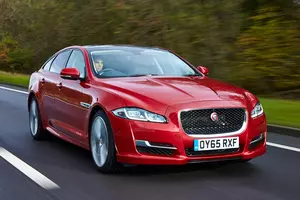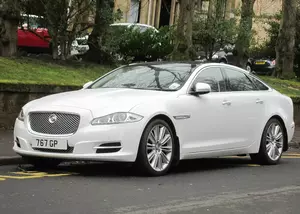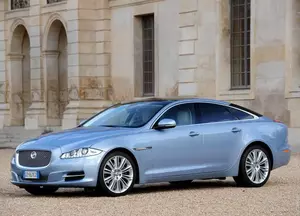
| Vehicle | Precise engine size | Difference from world average | Engine size to consumption ratio | Horsepower from 1 L | Engine size to 100 kg of weight |
|---|---|---|---|---|---|
| 3.0d V6 |
2.99 L (2993 cc) |
27.6% bigger | 73 cc to 1 mpg | 100 hp from 1 L | 158 cc to 100 kg |
| 3.0 V6 |
3 L (2995 cc) |
27.7% bigger | 115 cc to 1 mpg | 113 hp from 1 L | 166 cc to 100 kg |
| 5.0 V8 |
5 L (5000 cc) |
113.1% bigger | 238 cc to 1 mpg | 94 hp from 1 L | 263 cc to 100 kg |
| R 5.0 V8 |
5 L (5000 cc) |
113.1% bigger | 238 cc to 1 mpg | 115 hp from 1 L | 263 cc to 100 kg |
| 2.0 |
2 L (1999 cc) |
14.8% smaller | 71 cc to 1 mpg | 120 hp from 1 L | 111 cc to 100 kg |
| Vehicle | 3.0d V6 |
|---|---|
| Precise engine size | 2.99 L (2993 cc) |
| Difference from world average | 27.6 bigger |
| Engine size to consumption ratio | 73 cc to 1 mpg |
| Horsepower from 1 L | 100 hp from 1 L |
| Engine size to 100 kg of weight | 158 cc to 100 kg |
| Vehicle | 3.0 V6 |
| Precise engine size | 3 L (2995 cc) |
| Difference from world average | 27.7 bigger |
| Engine size to consumption ratio | 115 cc to 1 mpg |
| Horsepower from 1 L | 113 hp from 1 L |
| Engine size to 100 kg of weight | 166 cc to 100 kg |
| Vehicle | 5.0 V8 |
| Precise engine size | 5 L (5000 cc) |
| Difference from world average | 113.1 bigger |
| Engine size to consumption ratio | 238 cc to 1 mpg |
| Horsepower from 1 L | 94 hp from 1 L |
| Engine size to 100 kg of weight | 263 cc to 100 kg |
| Vehicle | R 5.0 V8 |
| Precise engine size | 5 L (5000 cc) |
| Difference from world average | 113.1 bigger |
| Engine size to consumption ratio | 238 cc to 1 mpg |
| Horsepower from 1 L | 115 hp from 1 L |
| Engine size to 100 kg of weight | 263 cc to 100 kg |
| Vehicle | 2.0 |
| Precise engine size | 2 L (1999 cc) |
| Difference from world average | 14.8 smaller |
| Engine size to consumption ratio | 71 cc to 1 mpg |
| Horsepower from 1 L | 120 hp from 1 L |
| Engine size to 100 kg of weight | 111 cc to 100 kg |

| Vehicle | Precise engine size | Difference from world average | Engine size to consumption ratio | Horsepower from 1 L | Engine size to 100 kg of weight |
|---|---|---|---|---|---|
| 3.0 V6 |
3 L (2995 cc) |
27.7% bigger | 115 cc to 1 mpg | 113 hp from 1 L | 166 cc to 100 kg |
| 3.0d V6 |
2.99 L (2993 cc) |
27.6% bigger | 73 cc to 1 mpg | 100 hp from 1 L | 166 cc to 100 kg |
| R 5.0 V8 |
5 L (5000 cc) |
113.1% bigger | 238 cc to 1 mpg | 115 hp from 1 L | 263 cc to 100 kg |
| 2.0 |
2 L (1999 cc) |
14.8% smaller | 71 cc to 1 mpg | 120 hp from 1 L | 118 cc to 100 kg |
| 5.0 V8 |
5 L (5000 cc) |
113.1% bigger | 238 cc to 1 mpg | 94 hp from 1 L | 263 cc to 100 kg |
| Vehicle | 3.0 V6 |
|---|---|
| Precise engine size | 3 L (2995 cc) |
| Difference from world average | 27.7 bigger |
| Engine size to consumption ratio | 115 cc to 1 mpg |
| Horsepower from 1 L | 113 hp from 1 L |
| Engine size to 100 kg of weight | 166 cc to 100 kg |
| Vehicle | 3.0d V6 |
| Precise engine size | 2.99 L (2993 cc) |
| Difference from world average | 27.6 bigger |
| Engine size to consumption ratio | 73 cc to 1 mpg |
| Horsepower from 1 L | 100 hp from 1 L |
| Engine size to 100 kg of weight | 166 cc to 100 kg |
| Vehicle | R 5.0 V8 |
| Precise engine size | 5 L (5000 cc) |
| Difference from world average | 113.1 bigger |
| Engine size to consumption ratio | 238 cc to 1 mpg |
| Horsepower from 1 L | 115 hp from 1 L |
| Engine size to 100 kg of weight | 263 cc to 100 kg |
| Vehicle | 2.0 |
| Precise engine size | 2 L (1999 cc) |
| Difference from world average | 14.8 smaller |
| Engine size to consumption ratio | 71 cc to 1 mpg |
| Horsepower from 1 L | 120 hp from 1 L |
| Engine size to 100 kg of weight | 118 cc to 100 kg |
| Vehicle | 5.0 V8 |
| Precise engine size | 5 L (5000 cc) |
| Difference from world average | 113.1 bigger |
| Engine size to consumption ratio | 238 cc to 1 mpg |
| Horsepower from 1 L | 94 hp from 1 L |
| Engine size to 100 kg of weight | 263 cc to 100 kg |

| Vehicle | Precise engine size | Difference from world average | Engine size to consumption ratio | Horsepower from 1 L | Engine size to 100 kg of weight |
|---|---|---|---|---|---|
| 2.0 |
2 L (1999 cc) |
14.8% smaller | 71 cc to 1 mpg | 120 hp from 1 L | 118 cc to 100 kg |
| 3.0d V6 |
2.99 L (2993 cc) |
27.6% bigger | 81 cc to 1 mpg | 92 hp from 1 L | 158 cc to 100 kg |
| 3.0 V6 |
3 L (2995 cc) |
27.7% bigger | 125 cc to 1 mpg | 113 hp from 1 L | 158 cc to 100 kg |
| Vehicle | 2.0 |
|---|---|
| Precise engine size | 2 L (1999 cc) |
| Difference from world average | 14.8 smaller |
| Engine size to consumption ratio | 71 cc to 1 mpg |
| Horsepower from 1 L | 120 hp from 1 L |
| Engine size to 100 kg of weight | 118 cc to 100 kg |
| Vehicle | 3.0d V6 |
| Precise engine size | 2.99 L (2993 cc) |
| Difference from world average | 27.6 bigger |
| Engine size to consumption ratio | 81 cc to 1 mpg |
| Horsepower from 1 L | 92 hp from 1 L |
| Engine size to 100 kg of weight | 158 cc to 100 kg |
| Vehicle | 3.0 V6 |
| Precise engine size | 3 L (2995 cc) |
| Difference from world average | 27.7 bigger |
| Engine size to consumption ratio | 125 cc to 1 mpg |
| Horsepower from 1 L | 113 hp from 1 L |
| Engine size to 100 kg of weight | 158 cc to 100 kg |

| Vehicle | Precise engine size | Difference from world average | Engine size to consumption ratio | Horsepower from 1 L | Engine size to 100 kg of weight |
|---|---|---|---|---|---|
| 2.0 |
2 L (1999 cc) |
14.8% smaller | 71 cc to 1 mpg | 120 hp from 1 L | 118 cc to 100 kg |
| 3.0 V6 |
3 L (2995 cc) |
27.7% bigger | 125 cc to 1 mpg | 113 hp from 1 L | 158 cc to 100 kg |
| 3.0d V6 |
2.99 L (2993 cc) |
27.6% bigger | 77 cc to 1 mpg | 92 hp from 1 L | 166 cc to 100 kg |
| R 5.0 V8 |
5 L (5000 cc) |
113.1% bigger | 250 cc to 1 mpg | 110 hp from 1 L | 263 cc to 100 kg |
| 3.0 V6 D |
2.99 L (2993 cc) |
27.6% bigger | 88 cc to 1 mpg | 92 hp from 1 L | - |
| 5.0 V8 |
5 L (5000 cc) |
113.1% bigger | 263 cc to 1 mpg | 94 hp from 1 L | - |
| 5.0 V8 Supercharged |
5 L (5000 cc) |
113.1% bigger | 263 cc to 1 mpg | 102 hp from 1 L | - |
| Vehicle | 2.0 |
|---|---|
| Precise engine size | 2 L (1999 cc) |
| Difference from world average | 14.8 smaller |
| Engine size to consumption ratio | 71 cc to 1 mpg |
| Horsepower from 1 L | 120 hp from 1 L |
| Engine size to 100 kg of weight | 118 cc to 100 kg |
| Vehicle | 3.0 V6 |
| Precise engine size | 3 L (2995 cc) |
| Difference from world average | 27.7 bigger |
| Engine size to consumption ratio | 125 cc to 1 mpg |
| Horsepower from 1 L | 113 hp from 1 L |
| Engine size to 100 kg of weight | 158 cc to 100 kg |
| Vehicle | 3.0d V6 |
| Precise engine size | 2.99 L (2993 cc) |
| Difference from world average | 27.6 bigger |
| Engine size to consumption ratio | 77 cc to 1 mpg |
| Horsepower from 1 L | 92 hp from 1 L |
| Engine size to 100 kg of weight | 166 cc to 100 kg |
| Vehicle | R 5.0 V8 |
| Precise engine size | 5 L (5000 cc) |
| Difference from world average | 113.1 bigger |
| Engine size to consumption ratio | 250 cc to 1 mpg |
| Horsepower from 1 L | 110 hp from 1 L |
| Engine size to 100 kg of weight | 263 cc to 100 kg |
| Vehicle | 3.0 V6 D |
| Precise engine size | 2.99 L (2993 cc) |
| Difference from world average | 27.6 bigger |
| Engine size to consumption ratio | 88 cc to 1 mpg |
| Horsepower from 1 L | 92 hp from 1 L |
| Engine size to 100 kg of weight | - |
| Vehicle | 5.0 V8 |
| Precise engine size | 5 L (5000 cc) |
| Difference from world average | 113.1 bigger |
| Engine size to consumption ratio | 263 cc to 1 mpg |
| Horsepower from 1 L | 94 hp from 1 L |
| Engine size to 100 kg of weight | - |
| Vehicle | 5.0 V8 Supercharged |
| Precise engine size | 5 L (5000 cc) |
| Difference from world average | 113.1 bigger |
| Engine size to consumption ratio | 263 cc to 1 mpg |
| Horsepower from 1 L | 102 hp from 1 L |
| Engine size to 100 kg of weight | - |

| Vehicle | Precise engine size | Difference from world average | Engine size to consumption ratio | Horsepower from 1 L | Engine size to 100 kg of weight |
|---|---|---|---|---|---|
| XJ6 3.2 i 24V Classic |
3.24 L (3239 cc) |
38.1% bigger | 154 cc to 1 mpg | 65 hp from 1 L | 180 cc to 100 kg |
| Vehicle | XJ6 3.2 i 24V Classic |
|---|---|
| Precise engine size | 3.24 L (3239 cc) |
| Difference from world average | 38.1 bigger |
| Engine size to consumption ratio | 154 cc to 1 mpg |
| Horsepower from 1 L | 65 hp from 1 L |
| Engine size to 100 kg of weight | 180 cc to 100 kg |